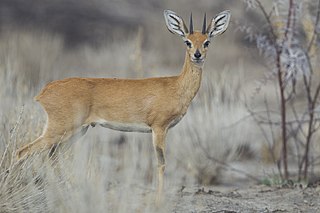
Bavayia is a genus of lizards in the family Diplodactylidae. Species in the genus Bavayia are also known commonly as New Caledonian geckos or bavayias. The genus is native to the remote New Caledonia and Loyalty Islands. The 41 species are moderately small to medium-sized geckos, and are distinguished from other genera by their tail length and the shape of their digits.

The tawny pipit is a medium-large passerine bird which breeds in much of the central Palearctic from northwest Africa and Portugal to Central Siberia and on to Inner Mongolia. It is a migrant moving in winter to tropical Africa and the Indian Subcontinent. The scientific name is from Latin. Anthus is the name for a small bird of grasslands, and the specific campestris means "of the fields".

The desert rat-kangaroo, also called the buff-nosed rat-kangaroo, plains rat-kangaroo or oolacunta, is an extinct small hopping marsupial endemic to desert regions of Central Australia. It was first recorded in the early 1840s and described by John Gould in London in 1843, on the basis of three specimens sent to him by George Grey, the governor of South Australia at the time.

Luzula campestris, commonly known as field wood-rush, Good Friday grass or sweep's brush is a flowering plant in the rush family Juncaceae. It is a very common plant throughout temperate Europe extending to the Caucasus. This species of Luzula is found on all types of native grasslands, and cultivated areas such as lawns, golf-course greens and fields.

Gryllus campestris, the European field cricket or simply the field cricket in the British Isles, is the type species of crickets in its genus and tribe Gryllini. These flightless dark colored insects are comparatively large; the males range from 19 to 23 mm and the females from 17 to 22 mm.

The steenbok is a common small antelope of southern and eastern Africa. It is sometimes known as the steinbuck or steinbok.

The campo flicker is a species of bird in the woodpecker family. It is found in a wide range of open and semi-open habitats in eastern Brazil, Bolivia, Paraguay, Uruguay and northeastern Argentina, with isolated populations in Amapá and southern Suriname.

The Italian wall lizard or ruin lizard is a species of lizard in the family Lacertidae. P. siculus is native to Bosnia and Herzegovina, Croatia, France, Italy, Serbia, Montenegro, Slovenia, and Switzerland, but has also been introduced to Spain, Turkey, the United States, and Canada. It is the most abundant lizard species in southern Italy.

Castilleja campestris is a species of Indian paintbrush known by the common name vernal pool Indian paintbrush. It is native to California and southern Oregon, where it grows in seasonally moist habitat, especially vernal pools.

The South African pouched mouse or southern African pouched mouse is a species of rodent in the family Nesomyidae, which is viewed as actually representing a complex of at least three undescribed species. It is found in southern Africa in Angola, Botswana, DR Congo, Malawi, Mozambique, Namibia, South Africa, Eswatini, Tanzania, Zambia and Zimbabwe. This species occurs in savanna woodland, as well as various other habitats, at elevations from 50 to 2000 m. It is present in arid regions of Namibia. The rodent is abundant and is tolerant of human disturbance of its habitat.

Bavayia crassicollis, also known as the strand bavayia is a gecko endemic to the Loyalty Islands in New Caledonia.

Bavayia sauvagii, also known commonly as Sauvage's bavayia and Sauvage's New Caledonian gecko, is a species of lizard in the family Diplodactylidae. The species is endemic to New Caledonia.

Dierogekko is a genus of geckos in the family Diplodactylidae. The genus is endemic to the northwest portion of New Caledonia. They are sometimes known commonly as the striped geckos or the New Caledonian geckos. Dierogekko are small geckos with simple, granular scales and subdued patterning of broad longitudinal stripes or spots. They are similar in overall appearance and habit to closely related geckos in the genera Bavayia and Oedodera, and the type species D. validiclavis was once referred to Bavayia.
Paniegekko is a monotypic genus of geckos in the family Diplodactylidae, containing the species Paniegekko madjo. It is endemic to humid montane forests on Mont Ignambi and Mont Panié in the Panié massif of New Caledonia. It was once considered a species of Bavayia, a similar genus of arboreal geckos. Paniegekko madjo is endangered, owing to predation by introduced rodents and cats combined with habitat degradation by wildfires and introduced pigs and deer. It has not been observed since 1998.
Pollichia campestris, commonly known as waxberry or barley sugar bush, is a herbaceous plant in the family Caryophyllaceae and the only species in the monotypic genus Pollichia. It is found in southern and eastern Africa and in the Arabian peninsula.
Bavayia ashleyi is a species of geckos endemic to New Caledonia.
Bavayia astrongatti is a species of geckos endemic to New Caledonia.
Bavayia boulinda is a species of geckos endemic to New Caledonia.
Bavayia caillou is a species of geckos endemic to New Caledonia.
Bavayia centralis is a species of geckos endemic to New Caledonia.












